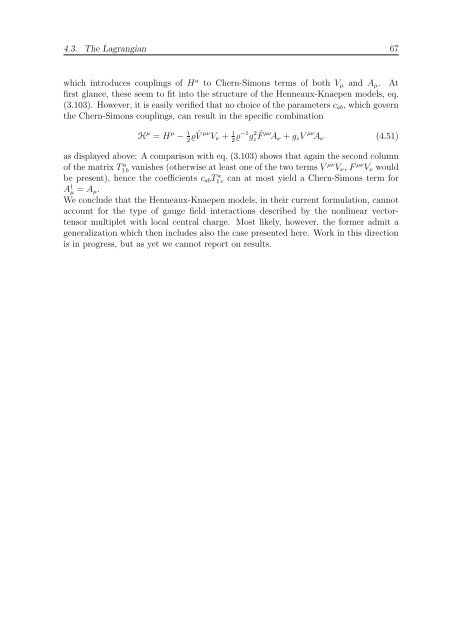N=2 Supersymmetric Gauge Theories with Nonpolynomial Interactions
N=2 Supersymmetric Gauge Theories with Nonpolynomial Interactions
N=2 Supersymmetric Gauge Theories with Nonpolynomial Interactions
You also want an ePaper? Increase the reach of your titles
YUMPU automatically turns print PDFs into web optimized ePapers that Google loves.
4.3. The Lagrangian 67<br />
which introduces couplings of H a to Chern-Simons terms of both Vµ and Aµ. At<br />
first glance, these seem to fit into the structure of the Henneaux-Knaepen models, eq.<br />
(3.103). However, it is easily verified that no choice of the parameters cab, which govern<br />
the Chern-Simons couplings, can result in the specific combination<br />
H µ = H µ − 1<br />
2 ϱ ˜ V µν Vν + 1<br />
2 ϱ−1 g 2 z ˜ F µν Aν + gzV µν Aν<br />
(4.51)<br />
as displayed above: A comparison <strong>with</strong> eq. (3.103) shows that again the second column<br />
of the matrix T a 1 b vanishes (otherwise at least one of the two terms V µν Vν, F µν Vν would<br />
be present), hence the coefficients cabT a 1 c can at most yield a Chern-Simons term for<br />
A 1 µ = Aµ.<br />
We conclude that the Henneaux-Knaepen models, in their current formulation, cannot<br />
account for the type of gauge field interactions described by the nonlinear vectortensor<br />
multiplet <strong>with</strong> local central charge. Most likely, however, the former admit a<br />
generalization which then includes also the case presented here. Work in this direction<br />
is in progress, but as yet we cannot report on results.

















